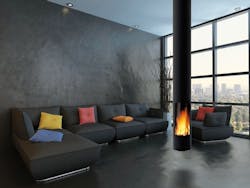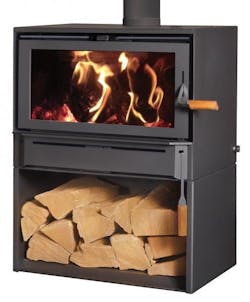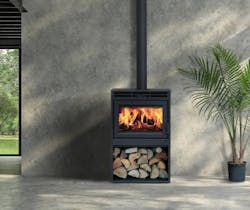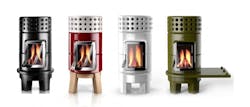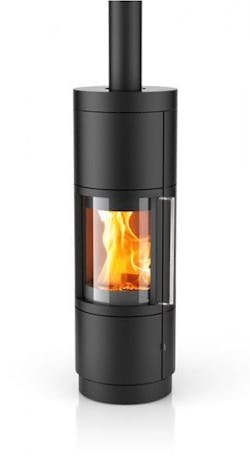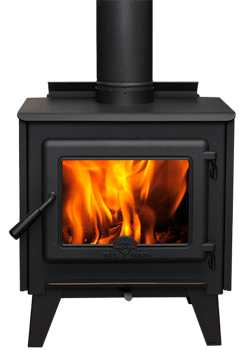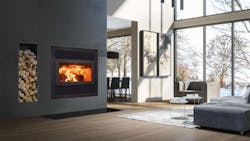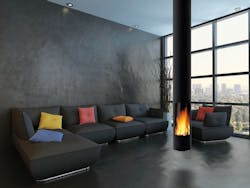The open-face fireplace has been disappearing due to clean air regulations, but residential construction professionals who want wood fire still have an option: a certified stove.
Wood-burning fireplaces have always been a part of American homes—first as the primary source of heat but then, with the advent of central heating, for ambiance. The fireplace served as the focal point of the living room and, therefore, family life, providing fires for cooking and baking, as well as a warm place to gather, relax, and read.
For a small portion of the U.S. population, though, wood-burning fireplaces are still the primary source of heat. In its 2010 census, the U.S. Census Bureau said that 2.1% of all homes burned wood as their primary heat source, up from 1.6% in 2000 (The increase was largely in rural areas). Additionally, data from the U.S. Energy and Information Administration shows that wood’s popularity as a main heating source in some areas of the country—such as the Northeast—saw its most significant recent increase from 2005 to 2012, the latest year for which federal figures are available.
[ Read More: HEARTH AND HOME: SELECTING A RESIDENTIAL FIREPLACE ]
The 77 percent efficient BX24 Boxer is an EPA-certified stove that is balanced to deliver a greater amount of radiant heat through the large glass door, the manufacturer says. It offers a 24-hour burn time on low and will heat 1,800 square feet.
But the truth is that traditional open-face wood fireplaces are terribly inefficient and not recommended in today’s energy efficient homes.
“While some people love the authenticity of a wood-burning fireplace, it is the least efficient method to heat your home,” writes Volunteer Energy, a Midwestern natural gas and electricity supplier that serves homes in Ohio, Michigan, Pennsylvania, and Kentucky. “A traditional masonry chimney and wood-burning fireplace loses 80-90% of the heat up the chimney. Plus, additional air inside your home is also pulled up and out through the chimney. To add to the problem the chimney creates an opening that causes heat and A/C loss throughout the year.”
The inefficiency of old fireplaces (as well as old wood-burning appliances such as stoves) is one reason the U.S. Environmental Protection Agency has been in a years-long campaign to convince homeowners to convert these old appliances to cleaner-burning units.
[ Read More: ORTAL INTRODUCES NEW WILDERNESS FIREPLACES WITH REALISTIC LOG ]
The Supreme Novo 38 wood burning stove is 75 percent efficient and offers a design that fits into a variety of interior design schemes. It can sit directly on the floor, or can be elevated on a podium to create a wood storage space. Buyer may customize the appearance of the firebox by choosing between two materials: soapstone or cast iron.
“Approximately 10 million wood stoves are currently in use in the United States, and 65 percent of them are older, inefficient, conventional stoves,” the agency says. These non-EPA certified wood stoves, the agency says, also can emit more than 1 ton of fine particle pollution into air during the cold months of the year. A successful wood-burning replacement program and changeout can significantly reduce harmful pollution, it adds.
The American Lung Association says smoke from residential wood heaters contains pollutants that can worsen indoor and outdoor air quality and cause harmful health effects, both long and short term. But switching to a new wood, natural gas, or pellet stove is a much better idea, ALA says. “The more efficient units are regulated by the EPA to control emissions, so a stove bought today is much cleaner-burning and releases fewer harmful air pollutants and carcinogens,” ALA says on its website. “By upgrading, residents can improve local air quality indoors and out, warm homes for less money, cut creosote build-up in chimney, and reduce the risk of fire.”
Consumers who want the ambiance of a fireplace without the inefficiency still have options. Gas fireplaces are an efficient option and electric fireplaces (some with blower elements for space heating) are great for apartment, condos, or in areas where a gas line is unavailable. But those want wood turn to a wood-burning stove.
Stack ceramic wood burning stoves are based on the concept of modular components which incorporate sections that are “stacked” on top of each other to create the unit as a whole. Offering an 84 percent efficiency (the shorter version), the product is made in Italy. It comes in two sizes of round and cubic models as well as 4 base options: slim, wood, long, and rim. Ceramic tile colors are: white, black, blue, green red, and orange.
Popular in Scandinavian countries and in Europe, wood-burning stoves are much different from fireplaces. More of a heating device, wood stoves have a tight door to prevent the unit from pulling combustion air from within the house, while fireplaces purposely allow some air leakage around their (mostly decorative) doors, says John Crouch, director of public affairs at the Arlington, Va.-based Hearth Patio & Barbecue Association, a trade ground that represents the hearth industry.
“Wood stoves can be either free standing or can be built into a wall, but they are all controlled combustion appliances,” Crouch explains. “The consumer controls the fire and the heat output by controlling the air flow. In fireplaces there is no real control of air, just of the amount of fuel put into the fire. Both products have glass doors, although the glass on a wood stoves is very high temperature glass.”
Hearthstone Quality Home Heating Products
Offering 76 percent efficiency rating, the Bari Plus wood stove incorporates TruHybrid combustion technology to bring a modern European EPA certified product to the North American market, the company says. It’s lined with thermal heat storage bricks on all sides of the firebox, and the extra height provides space for even more heat storage.
Many wood stove manufacturers claim their EPA-certified stoves burn with efficiency ratings up to 85 percent and many claim units can heat a house measuring up to 2,000 square feet. The efficiency numbers are similar to a gas fireplace, but it also comes with the ambiance and romance of a real fire.
“Wood stoves are much more efficient than fireplaces,” says Crouch. “They use very little air and the combustion is highly designed for optimum efficiency and minimal smoke. Fireplaces are not. Gas Fireplaces are very difficult to compare to wood fireplaces but do offer both decorative gas fireplaces and gas heating fireplaces. Both type offer a nice view of the fire, it’s just that one has a more sophisticated heat exchanger.”
The beauty of wood-burning stoves is that provide ambiance as well as have the ability to heat a house measuring up to 2,200 square feet, depending on the size of the unit. “That is their purpose,” Crouch says. “They can help reduce energy usage overall by ensuring that the house always has a source of radiant heat, which is especially welcome when coming in from a cold and wet winter outing. Most homeowners with wood stoves report that they use them for 60 to 90% of their homes’ heat.”
The TN10 wood stove offers an efficiency rating of you the best in compact economy. Engineered with an entry-level tube combustion system, this little performer is a great choice for occasional use rooms and small spaces requiring shorter burn times.
When it comes to wood stoves, European brands are known for blending high design with wood heating technology. French brand Focus Fires offers a wide variety of wood-burning stoves with closed combustion technology as well inventive design, such as the Slimfocus, which can be suspended (and pivot) or supported by a base and fixed in place. The company also offers a model called the Renzofocus that hangs from the ceiling and curves as it descends. It takes its inspiration from the ventilation ducts of Renzo Piano's Pompidou Centre in Paris, the company says.
Other brands that offers a clean, Scandinavian aesthetic include Wittus, Rais, Hearthstone, Supreme Fireplaces, and True North, among others.
When it’s time to select a stove, it’s a good idea to consider the material used in the construction. Cast iron is pretty standard, but many brands offer other materials such as soapstone, and ceramic plates to help distribute heat.
Another feature pros should look for is a stove with catalytic technology. Catalytic stoves send their smoky exhaust through a ceramic “honeycomb” catalyst, similar to a unit on a car. This unit burns off the gasses and particles, emitting fewer pollutants as a result, which is why catalytic stoves are typically more efficient than non-cat stoves, with longer burn times and less heat loss.
Finally, to get the best performing products, look EPA-certified wood stoves. As of May 2020, EPA's mandatory smoke emission limit for wood stoves has been lowered to 2.0 grams of smoke per hour. Luckily, stove manufacturers have improved their combustion technologies over the years, and now some newer stoves have certified emissions levels as low 1 g/h, the agency says. “When comparing models, look for the EPA white label on the stove—a lower g/h rating means a cleaner, more efficient wood stove.”
The Focus SBR is an EPA-certified fireplace insert that has a 75 percent efficiency rating. It has a 2.6-cubic-foot firebox and heats upwards of 2,000 square feet, a smart BurnRate System, and molded firebrick lining.
The manufacturer says the Slimfocus is the first suspended sealed wood stove. Offering an 82 percent efficiency, the unit is compatible with low-energy buildings because it draws in air for combustion through the smoke evacuation flue, the company says. It has a matte black finish.
